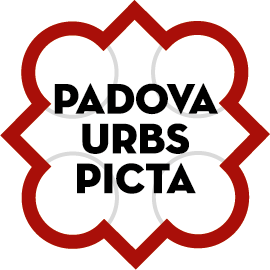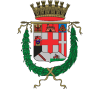This exploration of Via Dante begins at Piazza dei Signori.
The street was once known as Strà Maggiore [Great Street] because it was one of the busiest in the city: not only was it the route taken by all the traffic which entered the city by the Porta Molini gateway, but it was also lined by the homes of many families belonging to the local aristocracy. Alongside the Palazzo del Capitano once stood Lo Stallone [Big Stables], which housed a large number of horses; the building was subsequently used as warehouses and then even as a lazaretto. In 1642 the premises were sold to the Accademici Disuniti as a site on which to build a theatre, which would be in operation until 7 April 1778, when, as a chronicle of 1782 puts it, “a huge fire suddenly erupted and devoured the whole thing in less than two hours”. On this site, at the present-day number 5 Via Dante, now stands the majestic Palazzo Zigno, later the Palazzo Nani Mocenigo; this was designed by the architect Bernardino Maccarucci (1728-1798) for the the financier Antonio Zigno, who had bought up the remains of the Stallone buildings. To the right of the palazzo, at number 11 Selciato San Nicolò, is the ex-Oratory of St. Barbara; this was built in 1561, suppressed in 1818, and then became an inn before being used as a shop. The structure was once also the premises of the Scuola dei Bombardieri, the town militiamen. Opposite Palazzo Zigno, at number 10 Via Dante, is Palazzo Lonigo (formerly Palazzo Lion), which underwent extensive restructuring in the nineteenth century. At number 11 is Casa Riello (formerly Ca’ Monturso Montursi), which dates from the fourteenth century but has sixteenth-century alterations; it was originally built for the Montursi family, who were familiares [close associates] of Francesci “Il Vecchio” da Carrara. At number 15-19 stands Palazzo Vezzù (formerly Palazzo Bragadin-Fulgosio-Sala); the building was once also known as Palazzo degli Stati Uniti because in the 1880s it was home to a very popular beer shop named after the United States. In the facade of the building next-door one can see a six- and a four-light window. At number 38-40, on the corner with Via Verdi, stands Palazzo del Monte dei Paschi-Antonveneta (or Palazzo Dei Monti Vecchi); the name comes from the fact that in the seventeenth century it housed the Monte di Pietà [pawn bank]. The ground floor of the facade has wide arches resting on Ionic columns; the piano nobile has Corinthian columns dividing windows that correspond to the arches. The building was designed by the Paduan architect Simone de’ Sordi, who was also the sculptor of the statues of Padua’s patron saints that stand in niches on the first floor of the facade. The porticoed arcade that runs alongside Via Dante was opened in 1935, whilst within the bank itself one can still see a large paving slab that was part of the Roman road here. Opposite the building, again on the corner of Via Verdi and Via Dante, is an interesting L-shaped building by the architect Gino Adriani (1932-34); its floor plan reflects the junction of the two streets and links the buildings either end of it. With six floors above ground level, the building, which belongs to the Società Edilizia Padovana, has a ground-floor porticoed arcade in front of shop fronts, with an attic storey atop the upper five floors. Continuing down Via Dante, one comes, at number 56-58, to the Tower and Palazzo Da Rio (formerly, Palazzo Dotto de’ Dauli). This building became the property of the Da Rio family through marriage (in 1725), and then, in 1793, Count Girolamo Dotto de’ Dauli commissioned the proto [master builder] Angelo Sacchetti to work on the facade and the extension of the porticoed wing of the palazzo. Alongside it runs the narrow Vicolo dei Dotto, which ends at the former Cinema La Quirinetta, designed by the architect Quirino De Giorgio (1946-47). At number 55 is the neoclassical Palazzo Sacerdoti-Rusconi, which has a long porticoed colonnade that is decorated throughout its entire length with frescoes by Giovanni Demin. At number 63, on the corner of Via Sant’Agnese, is the small church of the same name. The main doorway in the facade is the work of Mario Mosca (also known as Zuan Padovano), with two saints (Ambrose and Augustine?). Within a niche is the small eighteenth-century statue of St. Agnes. Originally a lower structure, with a small portico down one side that was lined with tombs, the church is mentioned in documents as early as 1202, and would continue to be a parish church until 1808; it was an ancient local custom that a bride’s gown should be brought here for blessing. The bell-tower itself was restored in 1929 and – along with the bell tower which is now part of the City Hall – is considered to be the oldest in the city. At number 68-70 is the former Casa Marchi designed by Antonio Noale (1825).
At number 72 is the small neoclassical Palazzo Fasolo-Menin, again by Noale (1821); it contains frescoes by Giovanni Demin. The houses at number 65, 67-73 and 75-77 have interesting porticoes with double-arched lintels; the house at number 65 was the birthplace of Tullio Levi Civita (in 1873). One of the greatest mathematicians in Italy, he would die in Rome in 1941, isolated from the world of scientific research because of his Jewish background. This side of Via Dante (on the site of what are now 81-85 and 87-93) was occupied by various religious foundations right up to the early years of the nineteenth century: The Oratory of St. Joseph, maintained by the Guild of Carpenters; the convent of the Carmelite Nuns of St. Teresa,; the nearby church of San Polo (San Paolo). The latter housed the tombs of the Forzadura and the Borromeo families, as well as being the place where Tifi degli Odasi, the creator of what became known as macaronic verse, was buried in 1492. The convent and gardens of the Terese nuns extended as far as Via Sant’Agnese and Via San Polo. At number 74-80 and 82-86 there are the various houses that belonged to the Cittadella-Vigodarzere family: in order, Palazzo Mussato, Palazzo Cittadella and Palazzo Borromeo. The central building, with the central four-light window, dates back to the seventeenth century, while the one on the right – with the five-light window – dates from the fourteenth century. This palazzo received as guests Archduke Maximilian of Habsburg, who in 1857-59 was Austrian Vice-Regent of Lombardy-Veneto, and also the king of Italy Umberto I (in 1881).
At Number 90-92 is Palazzo Montesi-Borromeo; formerly Palazzo Diena-Da Lion-Braga-Forzadura-Taiamento, this was extended in 1780 and has its main entrance at 63, Via San Fermo. Inside the palazzo one can see the remains of Roman housing that once occupied this site: part of a tessellated floor, the central section of which dates from the first century A.D., with added terracotta tesserae dating from a century later. The overall composition forms a ‘central emblem’ of white, black and yellow tesserae, with depictions of kantharoi [drinking cups] at the corners. At number 97 is the former Palazzo Savonarola, with a wide-arched portico giving onto Via San Pietro. A little further on, at number 5 in the small square abutting the Porta di Ponte Molino (where Via Dante comes to an end), is a small building with a single-light window; this belonged to the nobleman Alvise Savonarola, who in 1794 rented the tower here from the local council. Via Sant’Agnese, Via Dante, Via San Polo and Via Rolando da Piazzola, were also once notorious for their concentration of casini (a word used to refer both to brothels and to gambling dens), closed down by law in the 1950s. At the Ponte San Leonardo end of Via Rolando da Piazzola, to the right – before you come to the bridge – is Via Tolomeo, which was formerly called Via Casin Rosso; the name came from a red-painted casino located here until 1786. And we know that in May 1787, by order of the Venetian Council of Ten, a number of soldiers and police were sent to surround another house of ill repute in the nearby Via del Colmellone (now Via San Pietro), closing it down for illegal gaming.
- DISCOVER
- LIVE
FOCUS
- GET INSPIRED
FOCUS
- INFO
- BOOK NOW












